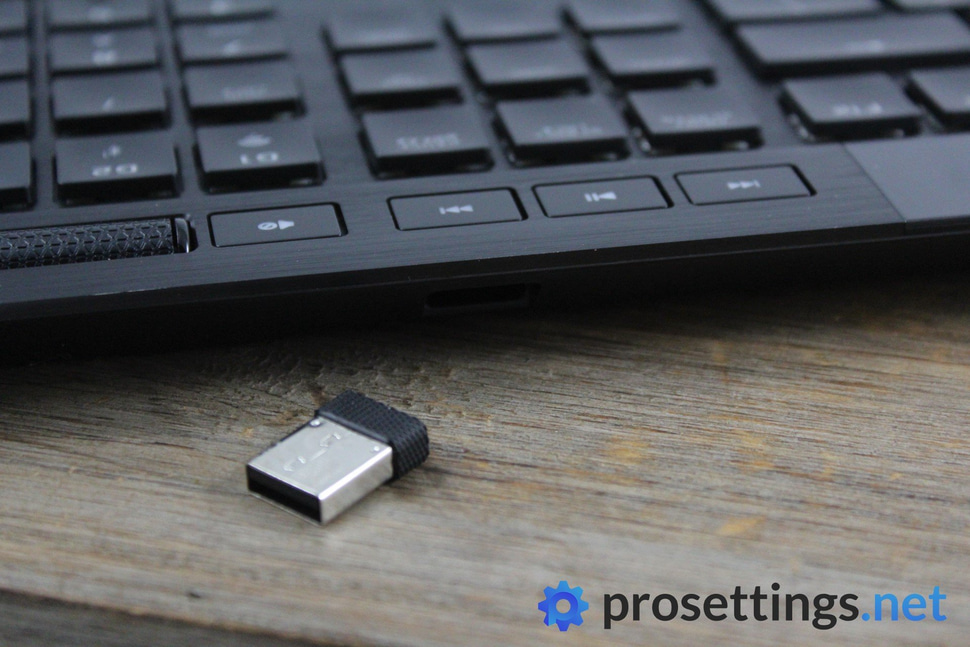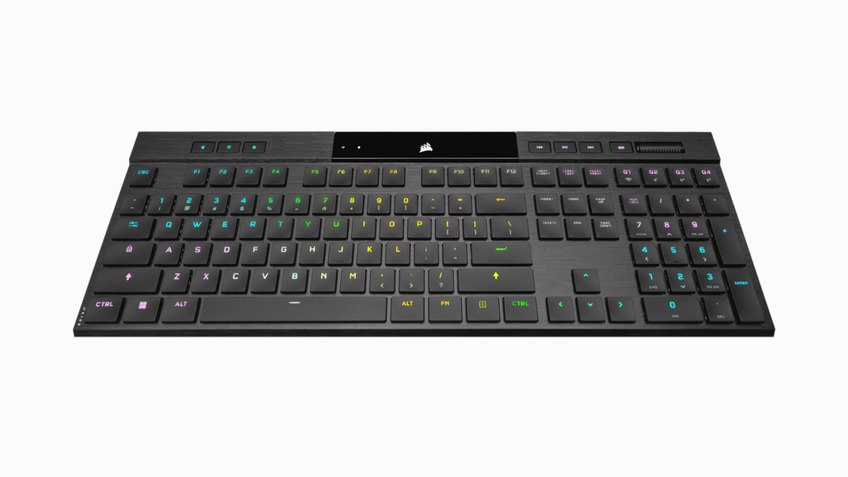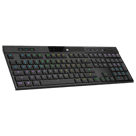Introduction
Corsair’s K100 keyboards have always been at the very top tier of the brand’s offerings, both in features as well as price. A couple of days ago, the K100 Air Wireless was released: an ultra premium, ultra thin gaming keyboard that’s sporting a set of unique and interesting features.
Coming in at 17mm of thickness (thanks to the inclusion of the brand new Cherry MX Ultra Low Profile switches) it’s among thinnest gaming keyboards that money can buy right now, and with the addition of features such as Hyper-Polling and Corsair’s AXON hyper-processing technology this should, theoretically, be an endgame-worthy keyboard. Read our full Corsair K100 Air Wireless review to find if that’s the case or not.
At A Glance
Corsair K100 Air Wireless
Ultimately, the Corsair K100 Air Wireless is an interesting product on a technical level, and I would recommend this board if it was around 100 dollars cheaper, but as it stands right now I don’t think it’s worth it unless you are absolutely in love with its specific combination of features and its thin design. There are better wireless keyboards out there, and there are better Corsair keyboards out there.
Pros
- Tons of customization options on the software side
- Very thin
Cons
- Stabilizers are rattly and distracting
- Keycaps aren’t great
- Edges of the aluminum case feel sharp/unpleasant
- Expensive
Specs
| Form Factor | Full Size |
|---|---|
| Switches | Cherry MX Ultra Low Profile |
| PCB | Non-Hotswappable |
| RGB | Yes |
| Height | 1.8cm |
| Width | 43.6cm |
| Length | 15.5cm |
| Weight | 780g |
First Impressions
One of the first things I noticed about the K100 Air Wireless wasn’t something about the board itself, but rather the price. With an MSRP of 279 USD, this is among the priciest gaming keyboards I’ve ever reviewed. That probably has something to do with the infamous ‘early adopter fee’ but still, it’s hard to look past that price when you could get an entry-level custom mechanical keyboard for that amount of money.
I won’t go on and on about the price (innovation costs money, and it’s not as if Corsair doesn’t have budget boards in their lineup) but I am mentioning it to frame this review. At this price, I expect a nearly flawless product, so I might seem a bit more critical in this review than I would be when I’m reviewing a 90 dollar budget board where you can reasonably expect some corners to be cut.
Regarding the board itself, it’s immediately noticeable how thin and sleek it is. With its brushed aluminum top and wafer-thin design, this board would not look out of place on the desk of designer professionals, and if you disregard the Corsair logo (which isn’t too gaudy or ‘gamery’ anyway) this barely even looks like a gaming keyboard.
The bottom of the K100 Air is made out of plastic, and I don’t particularly like that. It’s not something that bothers me on most Corsair boards, but at this price I would expect the chassis to be made out of aluminum completely. More on the build quality in the next section though.
The designers and engineers over at Corsair have always been at the top of their game as far as RGB goes, and it’s no different here: you get a myriad of options and lighting effects so that you can customize this board to look exactly the way you want it to look. The RGB doesn’t shine through consistently on keycaps with broader legends on them, though. The escape and control keys, for example, clearly have some bleeding around the edges where the RGB is noticeably less bright. It’s not a performance-impacting flaw of course, but it’s a touch disappointing from a brand that’s normally great at these kinds of things.
Packaging
The packaging isn’t anything special. It’s Corsair’s regular box, and inside of that you will find the board (along with a rather sturdy plastic protection cover), a cable, and some information. The wireless receiver is stored on the keyboard itself, which is something that I appreciate greatly.
Features and Build
At a thickness of around 17 millimeters at its highest point, the K100 Air Wireless is without a doubt the thinnest gaming keyboard I’ve ever tested. That may lead you to think that there could be build quality concerns, but I haven’t encountered any. The board flexes a little bit if you put a lot of pressure on it, but it doesn’t bend so far that it worries me.
Something that is somewhat grating (almost literally) is the fact that the edges are quite sharp. The aluminum top frame looks nice and sleek, but due to the fact that it overhangs the plastic bottom section, your fingers may touch the edges of the aluminum section at times. The fact that these edges feel quite rough and sharp bothers me; not because I cut myself on them or anything, but just because I don’t particularly enjoy that feeling of coming into contact with a rough metallic edge. That’s something that’s highly personal of course, but they still could’ve rounded off the edges a bit better if you ask me.

As with all of Corsair’s flagship keyboards these days, the K100 Air Wireless comes with AXON technology and the ability to use a polling rate of up to 8000Hz. To get polling rate that high, you will need to use the board in its wired configuration. As far as the ‘do you notice it’ question goes I can be quite short: I don’t, at least not really. I can’t notice any real differences between this and other fast boards such as the SteelSeries Apex Pro or something like that. I don’t mind the inclusion of this technology, and it’s nice to see that Corsair is pushing boundaries, but this isn’t a gamechanger. Treat it as a nice extra, and not as a selling point.
What I like about the board is that Corsair have been rather thoughtful in designing it. There’s a spot to place your wireless receiver, for example. I love that because it drastically reduces the chances of me losing it while I’m commuting or traveling. The board can also connect via Bluetooth, and there are buttons on the product to quick switch between up to four different devices; one via Slipstream wireless, three via Bluetooth. All of this leads to a product that’s suited for both gaming and professional use, which is a big plus because you’ll naturally want to be using this board for both work and pleasure in order to get the most out of its hefty price tag.
The keycaps, as you may have noticed, aren’t exactly standard. These caps are custom made for Cherry’s brand new Ultra Low Profile switches (more on those in the next section) and as a consequence, these caps aren’t interchangeable with any standard aftermarket keycap sets. Even if they were, Corsair has told me that you’re not supposed to take the keycaps off, so you wouldn’t be changing them out anyway. I don’t quite know how to feel about this. On the one hand, I’m fine with it because it’s not like there are any Ultra Low Profile keycap sets available on the aftermarket, but on the other hand it cuts down on possible personalization options.

To top it off, the keycaps don’t feel all that great. The very lightly textured surface feels somewhat powdery to me, and they also attract fingerprints and finger oils quite easily. I am not sure if these are ABS or PBT, but I would’ve loved to see a texture similar to what I found on the K70 Pro Mini Wireless, to name another recent Corsair board.
Turn the keyboard around and you’ll see one very long rubber strip at the bottom portion, along with rubber elements around the feet. These feet allow you to put the board at two additional angles. Thanks to the long strip at the bottom, this keyboard stays in place perfectly. I initially had some concerns on this front given the thin size and weight of it, but I had no issues with the board moving around at all during my testing.
Performance and Everyday Usage
Cherry MX already made Low Profile switches, but innovation of course never stops and the German brand has gone a step further and created Ultra Low Profile switches.
Inside my testing board I’ve got the ULP Tactile switches. These have a pre travel of 0.8 mm and a total travel of 1.8 mm, making them pretty darn fast, but due to the required actuation force of 66 grams they didn’t feel error-prone to me, something that I can struggle with on designated speed switches. The tactile bump isn’t as pronounced as it is on some enthusiast switches like Pandas or what have you but it does feel a lot more noticeable than what you get on a Cherry Brown. All in all, I actually really like how these switches feel. The tactile bump gives you a reassuring bit of feedback when pressing a key, and the low actuation force means that the switch can still be fast when you need it to be.
What I am not a fan of is the sound of this board, but I suspect that has more to do with the execution rather than with the switches themselves. The stabilizers on the board are rattly and loud, which really gets in the way of my enjoyment. The regular keys have this kind of inoffensive chiclet-style sound, and then you hit the spacebar and you’re met with a loud, rattly clank. I normally don’t really mind it when the stabs on a mass-produced keyboard aren’t up to par since I can just lube them myself if I want to, but given the fact that you can’t take off the caps on this board it is a massive bummer. Couple that disappointing sound with the awkward feeling keycaps and you’ve got a typing experience that I’m not a fan of.

To me, the beauty of mechanical keyboards is that you can customize them, and sadly the K100 Air Wireless seems to have taken a step back on that front rather than a step forward. I’ve received some loose ULP switches to take a look at in order to frame my review, and it seems like this is inherent to the design of these switches, which I find a little disappointing. Perhaps I am not the target audience for this kind of product, and I also realize that, with the way these switches are designed, it’s impossible to make them compatible with regular Cherry keycaps, but I would’ve at least liked to be able to lube these stabilizers myself without breaking the keyboard.
Back to the board itself then. The K100 Air Wireless sports an impressive battery life: you get 50 hours with the RGB lights on, and up to 200 hours with the lights turned off. I didn’t get to drain the battery to that extent all too often, but I did use it for multiple gaming sessions and I only had to charge it once. What’s also nice is that the USB cutout is wide enough to accept my custom cables, so if you’re stuck at a LAN tournament without juice or your included charging cable, you can grab a variety of USB-C cables to game with.
Corsair’s iCUE software isn’t new: it’s one of the most detailed, powerful pieces of customization programs out there, and this board allows you to customize just about anything. You can create a large variety of macros and profiles, and there’s room for up to 50 profiles (depending on the complexity of those profiles this might be a bit less) and up to 20 lighting layers. If you’re a tinkerer, you will be satisfied with what Corsair is offering here.
There are four macro keys that are situated above the numpad, and I love their placement. I’m not one for macros (in fact I don’t use them at all, except for on my productivity mouse) but I far prefer the placement of these keys over the design where the macro keys are placed on the left of the board. On the top section of the board, you’ll find the usual (for Corsair) media control keys, a programmable wheel, and some additional shortcut buttons to switch profiles, lighting, and lock the Windows key. All in all, this keyboard is packed with functionality and features.
Sound Test
Conclusion
The Corsair K100 Air Wireless is a very interesting product, but at the price that it is currently being sold at I can only recommend it to people who absolutely want a razor-thin gaming keyboard with lots of extra functionality, or for people who want the latest tech and don’t mind paying the early adopter fee.
The new Cherry MX Ultra Low Profile switches feel great to use in a vacuum, but they don’t reach their full potential in this board thanks to rattly and distracting stabilizers. The fact that you can’t do anything about these stabilizers even if you have the regular tools (keycap puller, lube, …) lying around because of the fact that you’re not supposed to remove the keycaps is disappointing.
Corsair’s AXON Hyper-Processing technology is impressive (though not really noticeable in gaming scenarios to me) and their customization options are up there with the very best, but the AXON tech can be found on a variety of other Corsair boards and iCUE works with all Corsair products, so if that’s what you’re after you can buy yourself into that ecosystem at much friendlier prices.
Ultimately, the Corsair K100 Air Wireless is an interesting product on a technical level, and I would recommend this board if it was around 100 dollars cheaper, but as it stands right now I don’t think it’s worth it unless you are absolutely in love with its specific combination of features and its thin design. There are better wireless keyboards out there, and there are better Corsair keyboards out there.
This product was received for free from the manufacturer and given to our reviewer to test and review. Brands and manufacturers have no editorial control over our reviews. For more information, check out our review FAQ.







